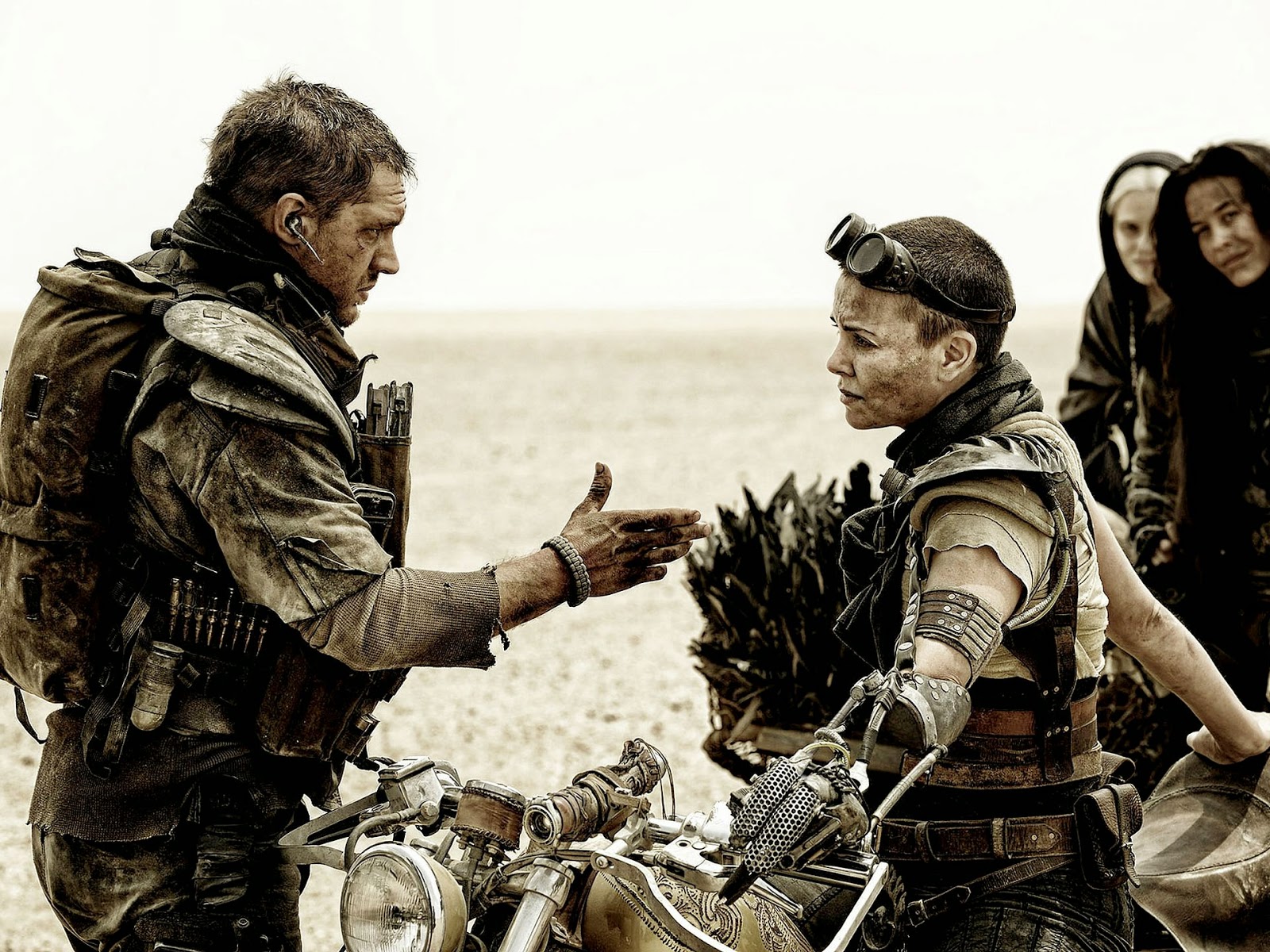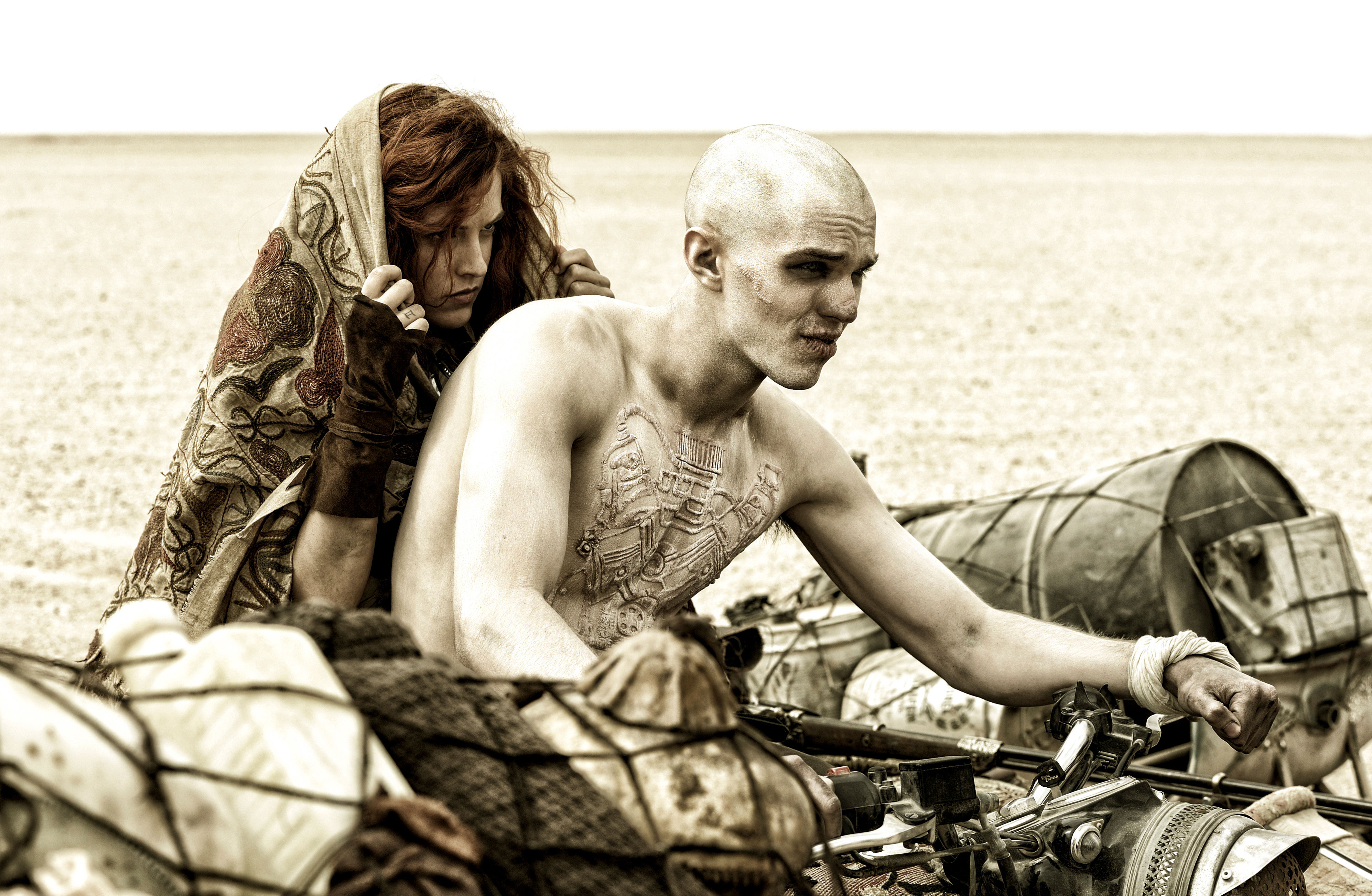Is “Mad Max: Fury Road” an example of modern “pure cinema”?
A two-hour car chase through the desert with very little dialogue. Inhuman characters covered in war paint, who pole vault between moving vehicles and throw exploding harpoons. A man who washes someone else’s blood off his face using breast milk. A blind guy harnessed to the front of a moving vehicle, endlessly playing a guitar that doubles as a flamethrower. An enormous man named Rictus Erectus, and a girl named Toast the Knowing.
These are descriptions from Mad Max: Fury Road (2015), a film the National Board of Review declared the “Best Film of 2015,” a film which has a 97% on Rotten Tomatoes, a Golden Globe nominated film for Best Drama, and the fourth installment in a franchise dating back to the late ‘70s. What is it about this crazily-conceived re-visitation of a cult favorite that has demanded such universal praise? Most cite a keen blend of apt filmmaking, character development, pacing, editing, sound, and above all, an understanding of the power of cinema as a visual medium. Fury Road can be seen as what many refer to as modern “pure cinema,” or cinéma pur, a term referring to the avant-garde movement of cinema defined by its elemental origins of vision and motion.

Cinéma pur is a French abstract-film term originating from Paris in the mid-1920s. This French Impressionist style was based on new techniques unique to film, as opposed to the commercial Hollywood-style cinema, which borrows narrative techniques from literary and theatrical art. Works of pure cinema are non narrative, based on rhythmic and abstract visual qualities, as well as form and motion.
As “pure cinema” in a 2015 context, Fury Road excels. Its script is minute and its plot can be summarized with a single sentence, but its storytelling is rich and complex, full of characters who undergo change through mostly nonverbal behavior. It is certainly a Hollywood picture, but its composition and performances speak to the power of rhythm, visuals, and motion. Unlike most action movies where scenes are slowed down or adjusted to create a particular effect, much of Fury Road is sped up to keep an established pace and cadence. It knows when to calm down and allow for breathing room, when to inject wide shots and close-ups, and evolves into a primarily visual piece of storytelling.
No character in Fury Road is inherently evil or inherently good. Instead, the film presents a mixture of people tied to a unifying thematic question: can humanity be retained in a world gone mad?
The film’s protagonists—Max (Tom Hardy), Furiosa (Charlize Theron) and Nux (Nicholas Hoult)—evolve into their protagonism through personal journeys directed at the reclamation of their humanities. Max is in search of redemption for the failures of his past; Furiosa seeks to restore the sanctity of her childhood in a world not ravaged by apocalyptic death; and Nux seeks a life higher than his existence as a war tool for the cruel patriarchy of Immortan Joe (Hugh Keays-Byrne). While all three have failures and make hard decisions in order to surivive, these characters stand in contrast to Joe and his army who have long cast aside humanity and lived by enslaving others for their own benefit and pleasure. The film shows the “good guys” attempting to preserve society in the face of objectification, to the detriment of the less-human rulers currently in control.
What makes Fury Road acclaimed as an action masterpiece is that all of this is developed with virtually no conversation, akin to pure cinema. Dialogue is rarely used to further the story, and when lines are spoken, they are never expository. Every word means something. George Miller presents a film loaded with meaningful images and actor performances that develop the story through an overwhelming visual experience, heightened by an other-worldly color palette and a whirlwind of practical effects and stunts that comprise most of the film.
The New York Times writes, “Viewers raised on the more baroque, digitally enabled forms of blockbuster spectacle are likely to admire the relative simplicity of Fury Road, while aficionados of the traditional slam-bang methods will revel in its coherence. Even in the most chaotic fights and collisions, everything makes sense. This is not a matter of realism but of imaginative discipline. And Mr. Miller demonstrates that great action filmmaking is not only a matter of physics but of ethics as well. There is cause and effect; there are choices and consequences.”

Fury Road is far from narratively complex, instead distinguishing itself from the ilk of other big-budget action films with its ability to evoke through imagery, in the spirit of pure cinema. Furiosa describes her quest in one word: “Redemption.” At the beginning of the film, Max goes so long without speaking that we almost wonder if he can use language. The characters don’t explain themselves or tell us their motivations. We don’t need deep explanations of the world or how it works or a deep understanding of how things got the way they are. Fury Road shows us a specific series of events with a specific group of people, and we see them unfold and impact the characters in a natural way within that context via the core tenets of filmmaking.
Brian Tallerico writes, “The pacing, the sound design, the editing, the music, and even the emotional stakes are all so far above average that they make just about any other car-chase movie look like a quaint Sunday drive by comparison… It’s no exaggeration to say that, if you think something in Fury Road is the most breathtaking action stunt you’ve seen in years, you really need only wait a few minutes to see something better. This is a movie where you keep thinking that it’s reached its apex and then, inexplicably, that moment is left behind in the dust.”
Those practical effects are another of the film’s strong points. When a film spends its entire runtime following some vehicles speeding through the desert among various war fights, capturing those effects for real goes noticed. Miller opted for real-world effects wherever possible, using CGI mainly on the landscape, not the action, and for tricks like Furiosa’s robotic arm.

Further, the action is almost always present at the center of the frame, allowing the film to become a visual experience that is easily followed and understood despite the chaos that may be happening all about its periphery.
The New Yorker says Miller has a “near-mystical prestige as a creator of action films: a bright, instinctive sense of when and where to cut from the telling detail to the wider view, and back again. Those instincts were there in the first Mad Max (1979), which, for all its cheapness, picked up rhythm whenever it hit the highway, and they are resurgent here. They connect Miller not so much to the panicky despots of the modern blockbuster, like Michael Bay, as to directors of Hollywood musicals, and to the early choreographers of the chase, in the wordless days when pictures lived by motion alone.”
Mad Max: Fury Road contains more than a few moments where the story can advance, character depth can be relayed, and alliances can be formed from little more than a look or a movement. That is the type of complexity rarely seen in action films, which harkens back to Hitchcock and even earlier to pure cinema, and which has distinguished Fury Road from the superficial mess of insanity it easily could have been. For that, it has earned accolades as a Best Picture contender and found success with audiences and critics alike.

